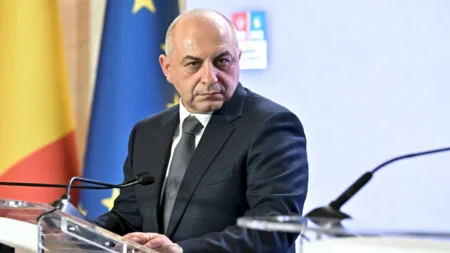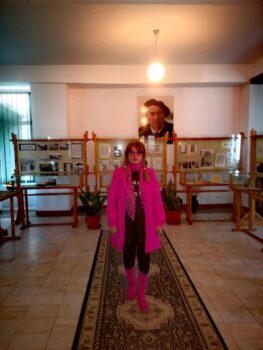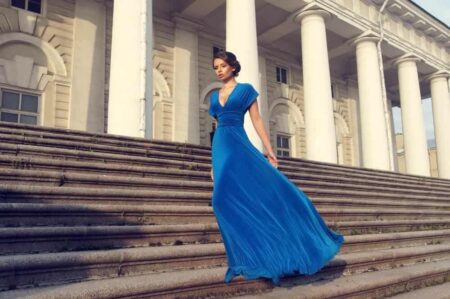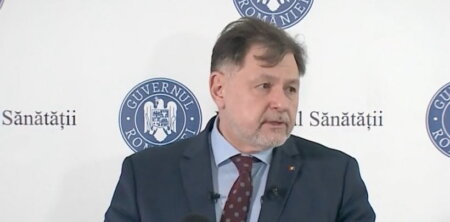 Space is the medium of all visual arts and Bogdan Lascar’s art is no exception. What makes it exceptional is that he takes space as a painter might use a canvas – as his experimental territory upon which to test the alchemy of spiritual and corporal understandings of it. And the result of his experiments takes the viewer beyond art on a journey that takes the visual as his starting point ut goes far above it to a web of experience outside art itself.
Space is the medium of all visual arts and Bogdan Lascar’s art is no exception. What makes it exceptional is that he takes space as a painter might use a canvas – as his experimental territory upon which to test the alchemy of spiritual and corporal understandings of it. And the result of his experiments takes the viewer beyond art on a journey that takes the visual as his starting point ut goes far above it to a web of experience outside art itself.
Born in Bacau (Romania) in 1974, Bogdan Lascar first explored sculpture during his studies at the Academy of Fine Arts in his country’s capital. But from sculpture, Lascar developed his artistic vision to integrate more dimensions, culminating in what he calls “metavisual” works of art. Aiming for a new type of expression and a new type of perception on the audience’s side, metavisual works occupy the space between projection and actuality forming a controlled escape from the actual plan of graphic expression.
Driving Lascar’s artistic voyage is the interplay between the audience and his work, tangible pieces becoming the trigger for abstract speculation and hyperindividualized semiotic field. His exhibitions themselves are laid out so as to take the audience on a personal journey through his metavisual landscape, fostering and encouraging the emergence of personal aesthetic experience through its successive presentation of works that can be interpreted as a vast field of interior symbolism turned outwards.
From the thin air and ambient space that surrounds the works, the audience is able to travel through an evolution of stages where mere shapings become eloquent expressions of meta-perception. From a structured contemplation, the gaze of the onlooker soon takes on the character of a personal passage to the hyper-individualized elaboration of an almost self-generated semiotics. Film installations extended with sculpture transcend the plane of the screen to inhabit the entire space, including the onlooker. All the elements are interconnected, but their meaning is revealed when the spectator walks through the space they inhabit, infusing it with her own spiritual and corporal significance, creating a unique reaction.
At the heart of this new artistic language are several fruitful and beneficial tensions, the culmination of which correspond to the appearance of meaning. Organic structures evoke a nostalgic interplay of space and memory, while complex engineering can be mistaken for intricate neural fields – the technical and the natural confronting each other to make a subtle impact on the audience. Integrating elements of avant-garde medecine into his lexis, the artist accompanies the audience through a cutting-edge and futuristic landscape while at the same time creating a backdrop of familiarity and history. Following this scientific tendency, Lascar has introduced into his approach a physical, almost medical, dimension. Concretely, these are his “Neurophysiologic shapings.” The expression is a wordplay involving his own native language, Romanian, and his interest for avant-garde medicalpractices and concepts. The Romanian “ne-ura” translates into the English “no-anger”, suggesting that the space both inhabited and created by Lascar is a place of contemplative reflection. At the same time, it invokes the scientific notion of neurophysiology and the way it determines and guides human actions and reactions. According to the artist, meta-artistic expression finds its place in the experience his work brings, namely in the guide of a physiology of no-anger: yet another example of how medicine intertwines with his artistic vision in order to summon up an entire universe where audience and work are in constant dialogue, giving meaning to each other.
“Neuro-shaping” occurs mostly as a “happening” and as a visual installation. Gestures appear in the plane of visual expression and creates a form of physical struggle, almost like a choreographed battle, between offensive and defensive actions taken in the world of meaning-creation. Stability is never achieved, always sought, and instability is made visible through the constant confrontation between polarized gestures and visual constructions.
Indeed, the domain of self-expression is the opportunity for the artist to bring forth a series of interrogations about the creation of meaning. According to him, “the force of the deconstructive gesture by projection in
the field of plastic expression becomes the power of constructive aesthetic gesture.” Self-expression thus becomes the locus of creation and destruction through the presence of the self that is reinterpreted by the gaze of the other. The form of “Calmeneuri” is the intricate process involving both the self-modeling of the artist and elements of self-defense skills. Through this procedure, the artist engages the audience in a reflection of the momentary creation of a meaning that is contemporaneous with the destruction of another. This complex method of gestures and postures and of the complementary relationship between the multifaceted meanings created and the simplicity of the “Calmeneuri” approach. Neurophysiological sculpture is also manifest is “free shapers”, which relies on the constantly evolving and changing centre of gravity of the object. Stability is sought through fluctuation – stability through instability, with outside actions triggering reactions within the sculpture. In this context, film installations and the epitome this flux and mutual meaning-generation. This interactivity generates an incessant communication characterized by change and vacillation. Body and object oscillate wildly to the point where the personal and the impersonal are indistinguishable. It is no longer clear who acts and who reacts, who destroys meaning and who creates it, who generates complexity and who generate speculative aesthetics. Abstraction and physicality co-exist to give life to the sculpture through the very interactive experience of viewing.
“Cromatic-Allusivoid” drawings add to the concept of Neurophysiologicalsculpture by combining figurative and abstract dynamics. These drawings, on surfaces of different shapes and textures, vary based on their thickness and on the number of layers they involve. They are applied to either flat or threedimension surface on all kinds of surfaces, from resin to canvas, and are supplemented by successive semi-transparent layers of oil colours. The relationship between the dynamism and movement of the layering, the multiplicity of media, and multi-dimensional nature of these drawings contribute to pushing the onlooker to see in them a architectural element that is also the expression of abstract musings. Graphics and volume unite to project optical iillusions and to once more accompany the gaze of the audience into a locus of uncertainty and questioning. The meta-visual takes on a prominent role in these works, revealing with utmost force the power of the artist’s work to disclose new modes of perception, like a deciphering through intuition. In addition to the role of the medium, the drawings’ narrative structure also challenge the viewer to reinterpret the entire concept of Neurophysiological scultpture.
Throughout Lascar’s work, the onlooker is struck by the fact that plastic expression remains a means to create such universes rather than an end in itself. Or to put it even more precisely, while artistic creation is in and of
itself the occasion to reflect upon its power to transform our understanding of art itself, it does so by conveying strong messages that are born from the interaction between the gaze of the onlooker and the work itself. So for instance, with his “framing concept”, collages of monumental frames for his own panels and sculptures, Lascar stages his work and produces several layers of his own work, almost as if to blur the distinction between his work, its setting, and the interpretation they generate. Artistic expression comes across not only through the works themselves but also through their miseen- scene.
All of these meta-visual works alternate between present and promise, between actual fact and future interpretation, all a function of the personal semantics and semiotics of the onlooker. The works are not discrete entities that can be interpreted outside of the web of their interrelations or outside of the relationship that binds them to the gaze of the viewer. They are truly and deeply “forms of communication” that cannot take the full meaning of their existence without the individual and speculative aesthetic of the audience, who as soon as they start building a rapport with the work also embark on a personal and existential journey that keeps evolving and changing. The new patterns of expression call for new patters of perception, which, while they necessarily make reference to current movements in visual arts, also attempt to break new ground and enter unchartered artistic territories. The body takes such an important place in Lascar’s work that he hasextended his activity beyond art itself in order to explore further the human physical experience. For the past decade, he has been a visual counselor and vice president of the “Lascar Foundation”, a non-profit that aims to inform the public about their medical needs and rights, but also to accompany people from all walks for life through various stages of their medical experience. One of its areas of focus is plastic surgery, training staff to use state-of-the-art techniques and technologies to achieve the best results. Another important aspect of the foundation’s goals is to accompany healing through exposure to art and creation – putting into practice the belief that through interaction with artistic creation, all are affected and transformed: creator, work, and onlooker.
Another influence on Lascar’s work as a whole is his experience of Eastern Europe under communist rule. Born in its midst, Lascar was inevitably witness to the interplay between the rigid totalitarianism of the political regime and the gruesome, erratic, chaotic, and very human revolution that opened the way for further evolutions of human experience. After monotone communism came revolution; after revolution came forays and explorations into nonconformity and personal expression, the piecemeal building of individual aesthetics through organic forms of expression. The complexity of the political and social results of post-communism are manifest in the larger than life metavisual artworks.
The conceptual framework that shapes the metavisual work of Lascar belongs to an avant-garde movement that is seeking new forms of expression of of perception. Through its internal tensions and paradoxes, and through its calling forth the viewer, Lascar’s work promises to open up paths of experience that have never been trodden before.















